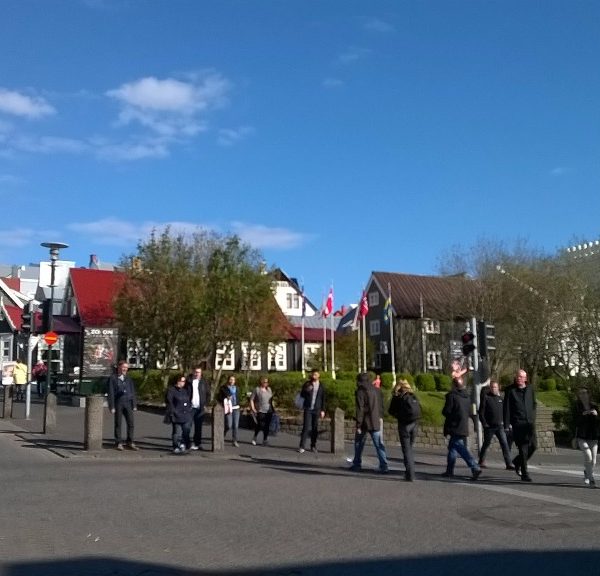Just a couple of weeks before we were due to arrive there had been snow and unseasonably cold temperatures in Reykjavik. This and the threat of a general strike had made us consider cancelling our trip. Fortunately, however, the strike was called off and the weather turned out to be fantastic, helping to make our trip extremely successful and enjoyable.
Our group of six convened at the clean and comfortable Downtown Hostel in Reykjavik on Sunday evening, 14th June, after arriving on different flights over the previous couple of days. We proceeded to the Icelandic fish and chip restaurant, overlooking the old harbour, where we swapped tales of our adventures so far. Even those who’d only arrived that day had at least seen the eery volcanic landscape of the Reykjanes peninsula and the backcloth of mountains still capped with snow on the journey from the airport at Keflavik.
At this time of year in Iceland the sun sets shortly after midnight and rises again at about 2.30am. Between those hours there is no real darkness, only a vague twilight. For the first few days we found this quite disorientating, not quite believing our watches when we suddenly realised on our evening strolls that it was approaching midnight and not about 10pm, as we’d imagined.
Reykjavik is the most northerly capital city in the world. With only 200,000 inhabitants it is compact and easy to negotiate, but nevertheless has a vibrant ambience, with lots of interesting bars and restaurants. Highlights include the Hallgrimskirka, a church whose design is inspired by the basalt columns of the Svartifoss waterfall, the new Harpa Concert Hall, which is a true gem of modern architecture and the open air Laugurdalur swimming pool with its geothermally heated water and hot tubs. Three of the group had also visited the nearby island of Viðey and got close up views of birds that are elusive in the UK including eider duck, snipe, golden plover, whimbrel and black tailed godwit.
The next day the six of us took two buses north of the city for a walk up Mount Esja, which at 914m would count as a Munro if transplanted to Scotland. We stared at sea level and the whole group made it to about 800m, to be rewarded with views out to the elongated Snaefellsnes peninsula, culminating in its ice-cap, some 80 miles away, but clearly visible through the clear, unpolluted air.
Beyond this there was an awkward section of loose scree followed by formidable-looking rocks. Half the party decided to descend at this point, while Andy, Jerry and Steve intrepidly continued to the snow-covered summit plateau, making this the first ascent of an Icelandic peak by a party from GOC.
On the Tuesday morning it was time to move on. A six-hour bus journey took us northward from Reykjavik, first following the west coast, then cutting across the interior and finally travelling eastward through the fjords of the north coast to Akureyri. The scenery was continuously interesting and variable, alternating between volcanic landscapes and fertile meadows with seascapes and snow-capped mountains as the backdrop. Indeed, the views were so stunning throughout our stay in Iceland that we soon ran out of superlatives to describe them.
Akureyri – about half way along the north coast and only 60 miles south of the Arctic Circle - is Iceland’s second largest settlement. Despite having only 20,000 inhabitants, the ‘city’ has a lively atmosphere and a spectacular setting at the head of the fjord, Eyjafjörður, and the foot of Mount Súlur. Our hostel was located a little bit out of town, but was handy for a nice bakery, where we had our breakfasts, and the Greiffin restaurant, where we dined with the locals in the evening.
The next day was 17 June, Iceland’s national day. Allan, Jerry, Steven and Tony joined in the celebrations as well as seeing the sights of Akureyri. Highlights included the botanic gardens (which, lying only 60 miles south of the Arctic Circle, have an incredible variety of plants) and the open air swimming pool, geothermally heated like the one in Reykjavik.
Meanwhile Andy and I decided to tackle Mount Súlur and were joined by a young Swede, whom we met at the start of the walk. After gaining the first peak (1150m) the three of us continued for a further kilometre through deep snow on a spectacular ridge to the second peak (1214m), which no one else reached that day. Kerling, which at 1538m is the highest mountain in north Iceland, seemed but a stone’s throw away, but was a bit beyond our reach.
The next morning we picked up two hire cars to drive to the mountainous Tröllaskagi peninsula west of Akureyri. En route we stopped to take the short ferry ride across to the island of Hrísey, with its pretty village of multi-coloured wooden houses. On a walk of about two hours we saw an amazing variety of birds, including ptarmigan, which in the UK is only found at the tops of Scottish mountains, and harlequin duck, which is a North American bird.
We were staying two nights at a remote guesthouse called Bjarnagil. This involved driving through three long tunnels. Two of these were single track with passing places, which was pretty scary for the uninitiated. The other, which was about 15 miles long and thankfully double track, had only been open a couple years. Prior to that the most direct route between the settlements of Ólasfsfjörður and Siglufjörður was a mountain road of some 40 miles, which at the time of our visit was still closed due to snow. Without the tunnel we would have had a detour of about 150 miles.
Our two-night stay Bjarnagil was definitely the highlight of our trip. Sibba and her husband Trausti, who had lived there for over 40 years now aged 66 and 72, had formerly kept 40 cows and the place still had a homely farmhouse atmosphere. Sibba gave us a very warm welcome and seemed to take a particular to Tony, the senior member of our group. We were treated to hearty breakfasts and evening meals of traditional Icelandic cuisine, all at a price that would be difficult to beat in the UK. This felt like the real Iceland and, although our hostel accommodation was excellent, we were really glad that we were now having a different and authentic experience.
While we were at Bjarnagil we visited the settlement of Hólar, which has the oldest stone church in Iceland and reconstructions of a 19th century turf farm and a 14th century bishop’s residence. From there we also walked to a viewpoint halfway up the mountain, then drove on to the village of Hofsós, where we swam in the geothermally heated ‘infinity pool’ dug into the rock at the edge of the fjord.
On Saturday 20th we were due to return to Akureyri, but had a full day at our disposal and decided to make the most of it. Andy and I visited the famous herring museum in Siglafjörður, then drove back through the tunnels to reach Hauganes just in time to join a whale-watching trip. Despite rough water and sea mist, we were rewarded with close up views of humpback whales. Allan, Jerry, StephenSteve and Tony made use of the other car to visit some of the most spectacular sights of north east Iceland including Lake Mývatn, with its lava formations and fumaroles (steam vents) and Dettifoss, the most powerful waterfall in Europe.
On Saturday evening we reconvened at the Greifinn for a farewell meal, which marked the end of the GOC trip. Some of the group stayed on in Iceland for a couple more days, but sadly space does not permit an account of their further adventures to be included here.
We all agreed that it had been a brilliant trip that exceeded our expectations in almost every way. Not only the scenery, but also the friendliness, helpfulness and unpretentious nature of the Icelandic people had made it special. Most, if not all, of us are keen to go back to Iceland, which is a surprisingly big country with much to discover.
Chris Loy











